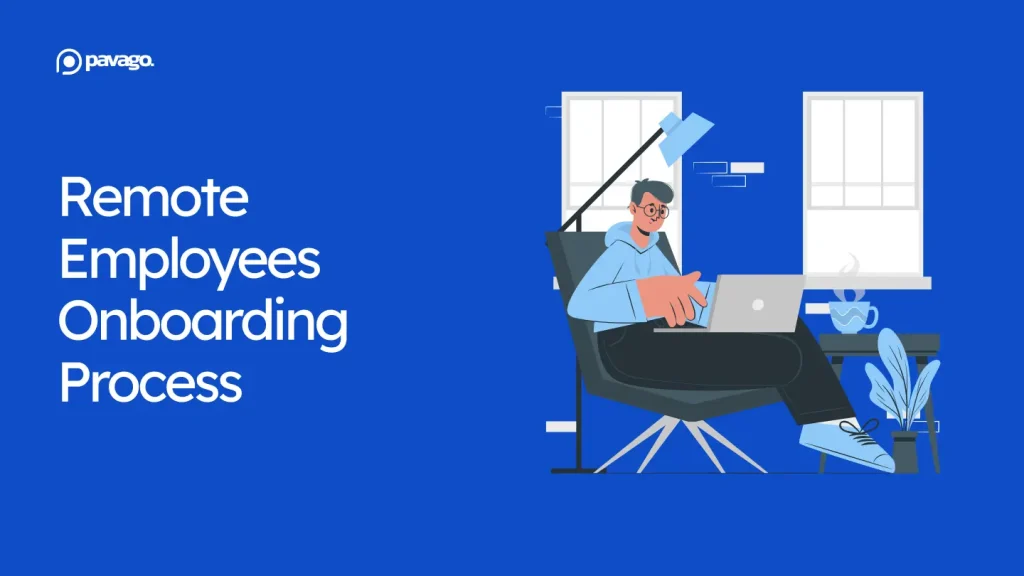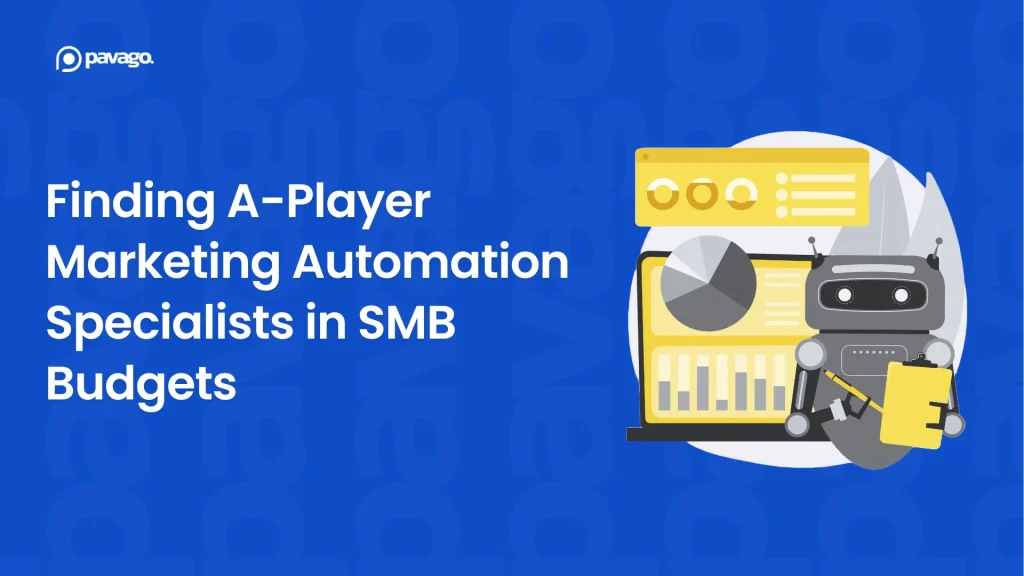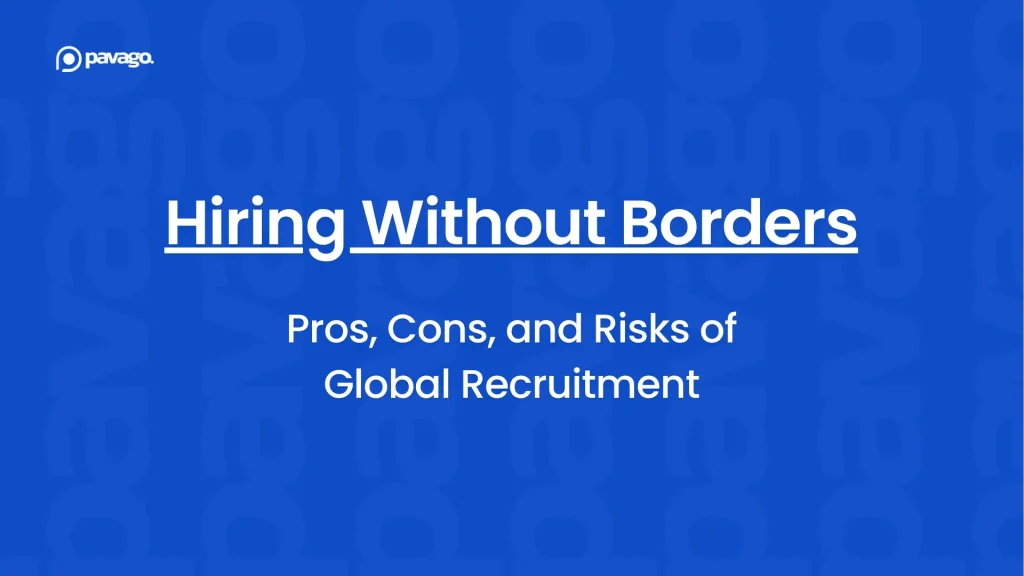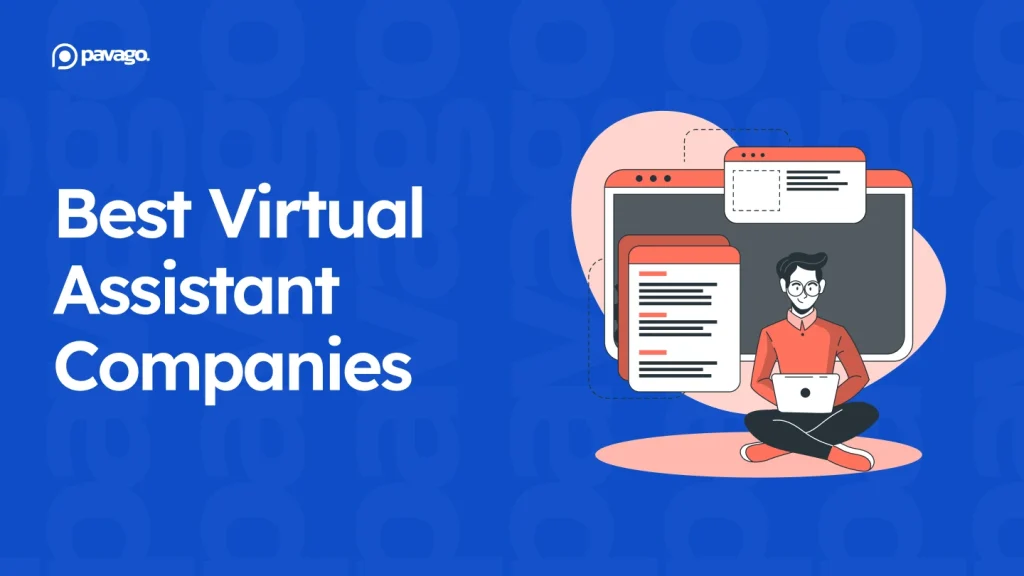33% of new employees quit within their first 90 days. For remote employees, the number is even higher because they’re trying to figure out your company while sitting alone in their home office.
The fix isn’t complicated. It’s about having a system that gets people up to speed fast and keeps them from feeling lost.
This article contains a complete remote onboarding checklist to help you onboard offshore employees with ease and set them up for success from day one.
But first, let’s take a look at why your current onboarding approach isn’t working.

Why Most Remote Onboarding Fails
The usual approach: Send them a laptop, add them to Slack, and hope they figure it out.
The problem: New remote employees waste 2-3 weeks just figuring out basic stuff like who to ask questions, which tools to use, and what they’re actually supposed to be working on.
The solution: A structured process that eliminates confusion and gets them contributing by day 5. Here’s the exact onboarding process we use at Pavago, refined after onboarding hundreds of remote employees.
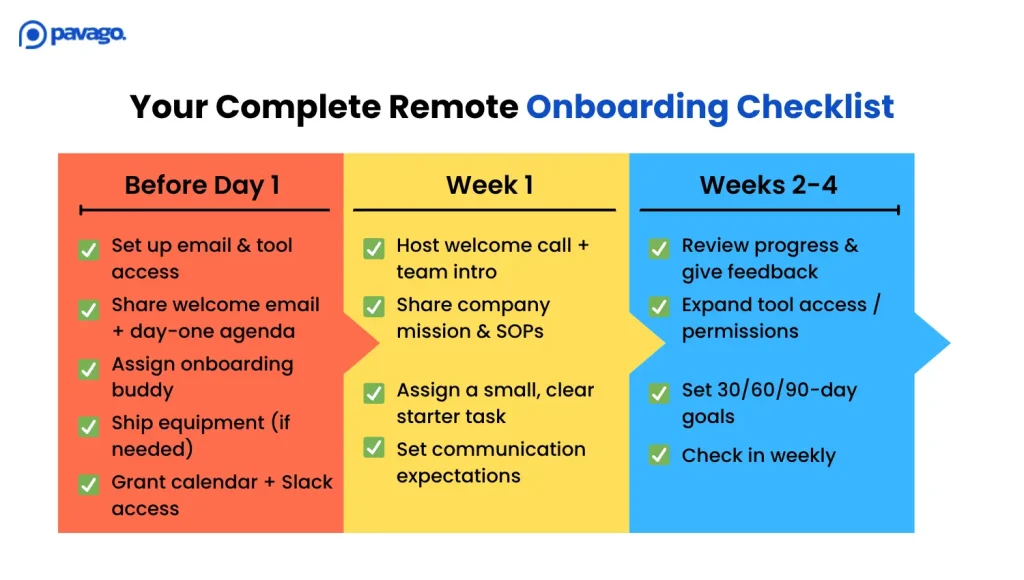
Pre-Onboarding: Set Them Up Before Day One
Tech Setup (Do This 1 Week Before They Start)
If you plan on providing your remote employees with equipment, ship it early with these items included:
- Laptop/monitor with all software pre-installed
- Step-by-step setup guide with screenshots
- Login credentials for all tools they’ll need
- Direct phone number for IT support
Also, create the following accounts in advance:
- Email account
- All software logins (Slack, project management tools, etc.)
- Company directory access
- Any industry-specific software
Schedule a tech test call 2 days before the start date to make sure everything works. Nothing kills momentum like spending their first day troubleshooting software.
Day One: Get Them Started Right
Hour 1: Manager Welcome Call (30 minutes)
Cover these four things:
- Why did you hire them? Be specific about what impressed you
- What success looks like in their first 30/60/90 days
- Their first assignment – something they can complete by the end of the week
- Who their main contacts are for different types of questions
Hour 2: Tool Walkthrough (45 minutes)
Don’t assume they know your tools. Walk them through:
- Communication system (Slack channels they should join, how you use email vs. chat)
- Project management tool (where to find their tasks, how to update status)
- File storage system (where to find documents, naming conventions)
- Any industry-specific software
Pro tip: Record this walkthrough so they can reference it later.
Rest of Day One
- Buddy introduction call (15 minutes) – assign someone they can ask basic questions
- Department overview meeting (30 minutes) – meet their immediate team
- First task assignment – something small they can complete and get feedback on
Week One: Build Momentum
Daily Check-ins (15 minutes each)
Same time every day, cover:
- What they worked on yesterday
- What they’re working on today
- Any blockers or questions
- One piece of feedback on their work so far
Don’t skip these. Remote employees can go off track fast without regular direction.
Essential Week One Activities
Day 2-3: One-on-one introductions with key people they’ll work with regularly
Day 4: First real project assignment. Assign them a project that:
- Has a clear deadline (1-2 weeks)
- Requires them to work with at least one other person
- Actually matters to the business
- Let’s them use the skills you hired them for
Nothing makes people feel more useless than busy work.
Day 5: Week one recap and feedback session
Weekly One-on-Ones
Structure these meetings:
- Performance: How are they doing on current projects?
- Problems: What’s blocking them or causing confusion?
- Progress: What do they need to learn or improve?
- Planning: What are their priorities for next week?
Integration Activities
Week 2: Department deep-dive (how your department fits into company goals)
Week 3: Cross-department introductions (sales, marketing, customer service, etc.)
Week 4: First formal feedback session and goal setting for month 2
Essential Tools for Remote Onboarding
Communication Stack
- Slack or Teams for daily communication
- Zoom for video calls and screen sharing
- Email for formal communication and external contacts
Project Management
- Asana, Trello, or Monday.com for task management
- Google Drive or SharePoint for file sharing
- Loom for creating training videos
Documentation
- Company wiki (Notion, Confluence, or even Google Docs)
- Process documentation for common tasks
- FAQ document updated based on new hire questions
The New Hire Portal
Create a single webpage or document with:
- All login credentials organized by category
- Who to contact for different types of questions
- Common processes with step-by-step instructions
- Company directory with photos and contact info
- First week schedule and key meetings
Set this up once and use it forever. You can also update this based on feedback from each new hire.
Measuring Your Remote Employee’s Success
Week 1 Goals
- All tools are set up and working
- Understands their role and first assignments
- Knows who to ask for help
- Completed the first small project
Month 1 Goals
- Contributing to real projects
- Working independently on routine tasks
- Building relationships with key team members
- Understanding company processes and culture
Metrics to Track
- Time to first contribution (goal: 1 week)
- 30-day confidence survey (are they confident in their role?)
- 60-day productivity assessment (are they hitting targets?)
- 90-day retention (did they stick around?)
Common Mistakes to Avoid
- Information overload on day one. Spread introductions and training over the first week.
- No clear first assignment. They should know exactly what to work on from day one.
- Irregular check-ins. Consistency matters more than frequency in the beginning.
- Assuming they know your tools. Even experienced people need to learn your specific setup.
- No feedback loop. Ask what’s working and what isn’t, then adjust.
More on this here: Problems With Hiring Offshore Talent in 2025 [& How to Avoid Them]
Special Considerations for Offshore Employees
When you hire international employees, you need to go the extra mile.
- Time zone coordination: Establish core overlap hours for meetings and communication.
- Cultural context: Explain not just what to do, but why you do things a certain way.
- Communication style: Be explicit about your preferences for directness, formality, and response times.
- Legal compliance: Make sure contracts and payment methods are set up properly from day one.
Get It Right and Save Yourself Headaches
Good remote onboarding isn’t about being perfect. It’s about being systematic. When new hires know what to expect and how to get help, they become productive faster and stick around longer.
The companies that do this well don’t just retain better employees – they turn them into advocates who help attract even better talent.
If you want to learn more about onboarding remote employees, managing them, or in fact hiring them, we’re always here
